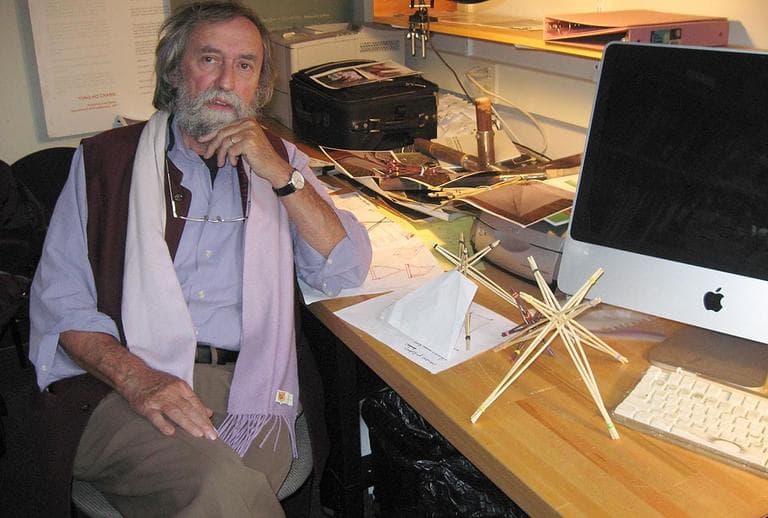Advertisement
MIT Team Works To Winterize Occupy Boston
Resume
Winter is quickly approaching, but protesters at the Occupy Boston encampment say they are staying put. In fact, they've won a temporary restraining order that makes it harder for the city to kick them out of Dewey Square. But a Massachusetts Institute of Technology architecture professor says the camp can't make it through the winter as is, so he's drafting a redesign of the site to protect the protesters and their tents from cold and snow.
MIT architecture professor Jan Wampler and about a dozen MIT students and alumni are doing voluntary consulting for Occupy Boston's "winterization working group." WBUR's All Things Considered host Sacha Pfeiffer visited Wampler at his office and asked him what the Occupy protesters are up against as temperatures drop.
Prof. Jan Wampler: If you're camping on the ground when it's frozen, you're basically on top of an iceberg.
Sacha Pfeiffer: It's really cold.
Very cold. And your body heat goes very quickly out. So the big issue is how you can insulate your body from the ground.
And you had an idea for that, which was put wooden pallets beneath the tents.
That's correct. That was the first idea, because an air space between you and the cold is the best. But we were told that we couldn't have wood.
By the city.
By the city. I think the reason was that it's perhaps a fire hazard. Then we tried to do that with plastic pallets. But that wasn't possible, as I understand, because it might create a place for rodents to be. So now we're back to trying to find ways of putting heavy insulation on the ground — two inches of foam or more — and then the sleeping bag would go over that.
You also have made the point that when snow starts to fall, which it inevitably will in Boston, those tents are going to be smothered in snow. So what do you do to keep the tents upright when the snow comes down?
Two issues, first of all. They're going to be smothered. The second is, how do you get rid of the snow? And it's interesting — we've come back to the Native American teepee, which was a beautiful invention.
These models we're looking at on your desk...
Are made out of wood, yes.
Tiny wood models of teepees.
That's correct.
Which you would put on top of the protesters' tents?
Exactly. And the point of that is that the snow then slides off the teepee. So this is like an outer shell, if you wish.
Like an umbrella for a teepee.
A big umbrella, but it's also providing a dead air space between the outside surface and their tents on the inside.
I'm assuming that even if the city signs off on a way for you to get people off the ground and to protect the tents with teepees, it's still going to be very cold inside those teepees. So how do you warm people inside their tents?
One way is to heat water off the site, bring it to the site, and then have the people living there fill water bottles they can take to sleep with them. A second idea is — from my experience of growing up — a hot brick in the bed at night.
Like in the old days.
I lived in a house that didn't have any heat, in a farmhouse. And that would keep you warm all night.
Until morning?
Yeah, the brick would still be relatively warm. Not hot, but warm.
Many of the ideas that you've proposed have been rejected by the city. Is that frustrating?
Very frustrating, yes.
Is your sense that the ideas that have been rejected are legitimate rejections? Or that the city may be hoping that if it just keeps saying no, these protesters will eventually go away?
I can't say. I think the city's point of view should be, obviously, for the health and welfare of the people there. On the other hand, I haven't understood exactly why some of the ideas that have been rejected relate to health.
I understand you are a veteran of the Vietnam War protests.
That's correct.
Does that mean the Occupy movement is one that you're sympathetic with?
Oh yes, very much so.
Do you think that once March, April roll around, once spring comes, there actually will have been protesters who stayed in Dewey Square throughout the whole winter?
I think so, based on my conversations with the people that are there. They're very energetic and they're very determined to stay there. Yes, I do.
So you think unless the city or the police oust them, they're going to tough it out?
They'll stay there. They'll tough it out.
You're a professor at MIT. You've been doing this job for 40 years. Does the work you're doing for Occupy Boston feel like as serious work as what you do here at the university?
Actually, the serious work that I do during the day with my students is telling them that in the design process, people come first. And in my international studios, we go around the world trying to help people that don't have the advantages of an architect. I believe that housing is not a luxury that a few should have. I believe that housing is a necessity that all people should have throughout the world.
Even protesters?
Of course, even protesters.
This program aired on November 17, 2011.